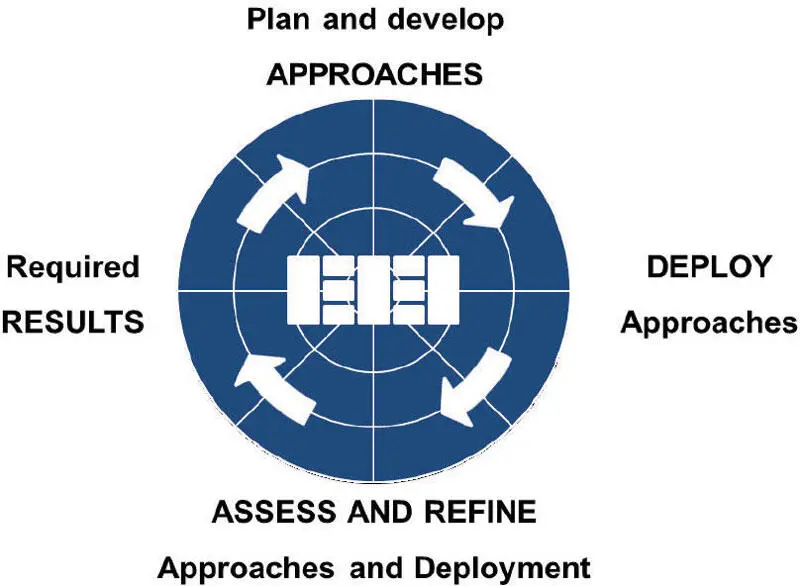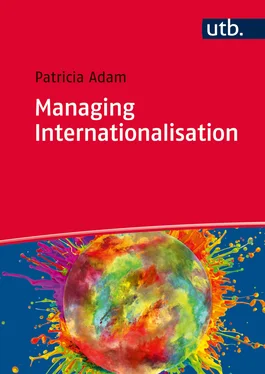
Figure 1-12: Exemplary Levels of the EFQM Excellence Model 31
It is important to keep in mind that the 119 guidance points used for exemplifying the five enabler criteria are not meant as a check list, so it is not necessary for an organisation to follow them all. Nor is the list of guidance points meant to be exhaustive, as there are other ideas and approaches that fit into a criterion part without being mentioned in a guidance point. The EFQM Excellence Model as an open and non-descriptive model allows and expects individual solutions that match business sector, size, culture and strategy of a specific organisation. However, the guidance points facilitate the search for a fitting improvement measure, in this respect being proper guides for a leader facing management challenges.

Figure 1-13: Exemplary Red Threads Through the EFQM Excellence Model 32
It is possible to follow certain ideas or aspects of management through the model as they are referred to in several guiding points. The EFQM depicts in their 2013 model brochure the integration of their fundamental concepts into the model by highlighting those criterion parts of the enablers where the text of a certain fundamental concept is reflected directly in one of the attached guiding points. 33This exercise can also be done in a broader sense for any aspect a manager would like to focus on, for example customers or ideas and impacts of the introduction of a risk management system. As shown in Figure 1-13, each of these aspects can be followed through the model. Ideas how to optimise the benefit from the customer’s perspective can be found for example in 1c (leaders are transparent and accountable to their customers and encourage them to participate in activities that contribute to the wider society), in 2a (gather customer’s needs and expectations as strategy input), 2b (analyse current performance trends, for example how customer expectations and promises to the customers are kept), 2d (communicate their strategy to their customers), 3b (attract the right people and ensure that all employees have the necessary competencies to fulfil the needs of the customers), 4a (identify and work together with partners to ensure enhanced value for the customers), 4c (optimise the impact of their product lifecycle and services on public health and safety including that of the customers), 4d (involve customers in the development and deployment of new technologies to maximise the benefits generated), 4e (establish approaches to engage relevant customers and use their knowledge in generating innovation), 5a (design and manage processes to optimise customer value – also beyond the boundaries of the organisation), 5b (develop products and services that create optimum value for customers), 5c (define different customer groups and anticipate their needs and expectations), 5d (produce and deliver products to need or exceed customer needs and expectations), and 5e (manage and enhance customer relationships). The outcomes of these approaches are measured in 6a and 6b (customer perceptions and performance indicators with impact on the perceptions of customers). Explanations concerning the depicted relevant criterion parts for people are provided online at the accompanying website combined with the solution to the following exercise.
 Exercise: Familiarise yourself with the EFQM structure (online)
Exercise: Familiarise yourself with the EFQM structure (online)
The internationalisation process that forms the structure of this textbook is based on the EFQM criteria. Therefore, more details of each criterion and the associated criterion parts will be explained at the beginning of the corresponding chapters. As this book will only present selected parts of the EFQM Excellence Model, it is highly recommended to acquire the original brochure of the model which can be obtained at www.efqm.org.
| 1.3.4 |
The EFQM RADAR Logic |
For assessing the excellence level of an organisation the EFQM offers a logical method based on the Deming or PDCA Cycle. According to the Deming Cycle a continuous improvement of processes or systems is based on several successive phases starting with establishing plans, processes and (measurable) objectives to the delivery of a certain output (PLAN), implementing and executing these plans (DO), reviewing the actual results (CHECK) and taking corrective actions in case significant differences between the actual results and the planned objectives occur (ACT). 34The PDCA-Cycle lies at the heart of all improvement-related management models and is used for example in the ISO 9001 quality management systems’ requirements.
The EFQM calls its derived approach RADAR® logic. It consists of four consecutive phases that an organisation needs to execute in order to ensure continuous improvement and sustainable outcomes and is represented in Figure1-14. In the first phase, the organisation determines the RESULTS it wants to achieve according to its strategy. In the second phase the organisation plans and develops an integrated set of comprehensive APPROACHES to deliver the results from an actual and future-oriented perspective. In the third phase the approaches are DEPLOYED systematically to ensure a successful implementation. In the fourth phase the organisation has to ASSESS and REFINE its approaches according to the analysis of the achieved results and based on its on-going learning activities. Therefore, the cycle starts again with defining the desired results. The degree to which an organisation is able to consequently follow this rigorous improvement cycle is the basis for assessing its level of excellence. For an EFQM assessment, a detailed set of requirements and possible levels of fulfilment based on the RADAR® cycle was invented that is depicted in the so called RADAR tools. One RADAR tool (also called RADAR matrix) deals with the results, as it depicts the first phase of the cycle and is thus used for the result criteria. The second RADAR matrix is used for the assessment of the enabler criteria and depicts the phases two to four of the RADAR logic.

Figure 1-14: The EFQM RADAR® Logic 35
VIPs

| 1.4 |
Process Model “Managing Internationalisation” |

Figure 1-15: The Internationalisation Process
The management logic of the EFQM Excellence Model can be used to define the path through the internationalisation process, as shown in Figure 1-15. The management process itself starts with leadership awareness and competence to steer the organisation through the internationalisation process. This is followed by the definition of an international strategy which sets the path for the following implementation. The strategy is implemented through the following steps: managing people in an international environment, managing international partners and resources as well as managing products and processes globally. Based on a sustainability approach the results achieved will be compared with the (strategic) goals set, defined by ways of an individual balanced scorecard. A strategy review based on the outcomes will follow to ensure that the longterm vision of the company is still valid and the path to be followed seen as appropriate. These internationalisation steps are supported by the development of crosscultural competence, which is required for every action and decision in internationally operating organisations. Therefore it defines the starting point for the following elaborations of this book.
Читать дальше



 Exercise: Familiarise yourself with the EFQM structure (online)
Exercise: Familiarise yourself with the EFQM structure (online)













